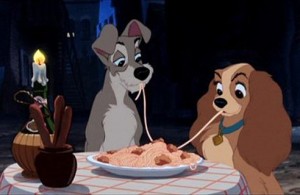Aladdin
Posted on December 13, 2002 at 5:17 am
A+| Lowest Recommended Age: | Kindergarten - 3rd Grade |
| MPAA Rating: | G |
| Profanity: | None |
| Alcohol/ Drugs: | None |
| Violence/ Scariness: | Characters in peril |
| Diversity Issues: | Class issues |
| Date Released to Theaters: | 1992 |
| Date Released to DVD: | October 5, 2015 |
| Amazon.com ASIN: | B00WR534TK |
One of the best of the contemporary Disney releases, this classic tale of the magic lamp benefits tremendously from the energy and humor of Robin Williams as the genie. Only the Disney animators could find a way to keep up with Williams’ pop culture torrent of a brain, and the big blue genie is a marvel of rapid-fire images and associations, deliciously irreverent, a nice surprise in a Disney film. This 2015 Diamond edition
Aladdin, a “street rat,” meets the beautiful Princess Jasmine, when she sneaks out to wander through the city. Jasmine refuses all of the men who want to marry her to get the throne and wants to find out more about the world outside the castle walls. Evil Jafar, the trusted advisor to the Caliph, sends Aladdin to get the magic lamp. The genie appears and offers Aladdin three wishes. Aladdin promises he will use the third wish to free the genie, and then wishes to be a prince, so he can court Jasmine.
But Jafar, too, wants Jasmine, and the kingdom she will inherit. Aladdin has to find a way to free the King from Jafar’s control using his own powers. And he has to find a way to feel comfortable enough about himself to allow Jasmine to know who he really is.
The songs by Alan Menken and Howard Ashman are tuneful, sparkling, and exceptionally clever, one of Disney’s all-time best scores. After Ashman’s death, lyrics for three songs were written by Tim Rice of “The Lion King” and “Jesus Christ, Superstar,” including those for the Oscar-winning song, “A Whole New World.”
Families who see this movie should discuss these questions: Why didn’t Aladdin want to tell Jasmine the truth? Why did Jasmine’s father trust Jafar? If you had three wishes, what would they be?
Disney issued two made-for-video sequels, “The Return of Jafar” and “Aladdin and the King of Thieves” (only the second one featuring Williams), both very entertaining. Parents may have concerns about some aspects of the story in the second. Aladdin behaves in an honorable and accountable fashion, there is a fairly happy resolution of the relationship between Aladdin and his father, Kaseem, and Kaseem acknowledges that the relationship with his son is “the ultimate treasure.” However, Kaseem’s original desertion of Aladdin and his mother and his failure to care for Aladdin after his mother’s death are never really justified or apologized for; nor does he ever address or repent for his his lifelong career as a thief. Kaseem seems unconcerned when the outlaws insist that Aladdin pass the test for becoming one of them, a fight to the death, and almost casually approves. He leaves the outlaws to drown when their ship sinks. And at the end, he rides off with Iago the parrot (again voiced by the wickedly funny Gilbert Gottfried), apparently to return to a life of crime. Parents should be prepared for questions, and may want to initiate discussion of how Aladdin might feel about his father and why he has decided to make different choices in his own life.

